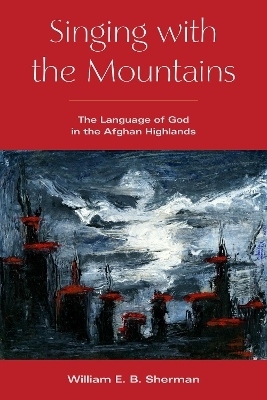
Singing with the Mountains
The Language of God in the Afghan Highlands
Seiten
2023
Fordham University Press (Verlag)
978-1-5315-0567-7 (ISBN)
Fordham University Press (Verlag)
978-1-5315-0567-7 (ISBN)
An illuminating story of a Sufi community that sought the revelation of God.
In the Afghan highlands of the sixteenth century, the messianic community known as the Roshaniyya not only desired to find God’s word and to abide by it but also attempted to practice God’s word and to develop techniques of language intended to render their own tongues as the organs of continuous revelation. As their critics would contend, however, the Roshaniyya attempted to make language do something that language should not do—infuse the semiotic with the divine. Their story thus ends in a tower of skulls, the proliferation of heresiographies that detailed the sins of the Roshaniyya, and new formations of “Afghan” identity.
In Singing with the Mountains, William E. B. Sherman finds something extraordinary about the Roshaniyya, not least because the first known literary use of vernacular Pashto occurs in an eclectic, Roshani imitation of the Qur’an. The story of the Roshaniyya exemplifies a religious culture of linguistic experimentation. In the example of the Roshaniyya, we discover a set of questions and anxieties about the capacities of language that pervaded Sufi orders, imperial courts, groups of wandering ascetics, and scholastic networks throughout Central and South Asia.
In telling this tale, Sherman asks the following questions: How can we make language shimmer with divine truth? How can letters grant sovereign power and form new “ethnic” identities and ways of belonging? How can rhyme bend our conceptions of time so that the prophetic past comes to inhabit the now of our collective moment? By analyzing the ways in which the Roshaniyya answered these types of questions—and the ways in which their answers were eventually rejected as heresies—this book offers new insight into the imaginations of religious actors in the late medieval and early modern Persianate worlds.
In the Afghan highlands of the sixteenth century, the messianic community known as the Roshaniyya not only desired to find God’s word and to abide by it but also attempted to practice God’s word and to develop techniques of language intended to render their own tongues as the organs of continuous revelation. As their critics would contend, however, the Roshaniyya attempted to make language do something that language should not do—infuse the semiotic with the divine. Their story thus ends in a tower of skulls, the proliferation of heresiographies that detailed the sins of the Roshaniyya, and new formations of “Afghan” identity.
In Singing with the Mountains, William E. B. Sherman finds something extraordinary about the Roshaniyya, not least because the first known literary use of vernacular Pashto occurs in an eclectic, Roshani imitation of the Qur’an. The story of the Roshaniyya exemplifies a religious culture of linguistic experimentation. In the example of the Roshaniyya, we discover a set of questions and anxieties about the capacities of language that pervaded Sufi orders, imperial courts, groups of wandering ascetics, and scholastic networks throughout Central and South Asia.
In telling this tale, Sherman asks the following questions: How can we make language shimmer with divine truth? How can letters grant sovereign power and form new “ethnic” identities and ways of belonging? How can rhyme bend our conceptions of time so that the prophetic past comes to inhabit the now of our collective moment? By analyzing the ways in which the Roshaniyya answered these types of questions—and the ways in which their answers were eventually rejected as heresies—this book offers new insight into the imaginations of religious actors in the late medieval and early modern Persianate worlds.
William E. B. Sherman is an Assistant Professor of Islamic Studies in the Department of Religious Studies at the University of North Carolina at Charlotte.
Preface: First Words | vii
Acknowledgments | xi
Mountains and Messiahs: An Introduction | 1
1 Bayazid’s Doubles: Hagiography and History in the Messianic Community | 29
2 The Dhikr of the Wretch: Text, Practice, and the Roshani Self | 62
3 Revelation through Repetition: The Roshaniyya Write the Word of God | 90
4 Vernacular Apocalypse: Poetic and Polemical Emergences of Pashto Literature | 118
5 The Vanguard of Disbelief: Afghan Ethnicity and Temporality after the Roshaniyya | 151
Ishmael’s Daydream: A Conclusion | 180
A Note on Sources | 189
Notes | 193
Bibliography | 227
Index | 253
| Erscheinungsdatum | 07.11.2023 |
|---|---|
| Zusatzinfo | 1 Maps |
| Verlagsort | New York |
| Sprache | englisch |
| Maße | 152 x 229 mm |
| Gewicht | 544 g |
| Themenwelt | Geisteswissenschaften ► Geschichte ► Regional- / Ländergeschichte |
| Geschichte ► Teilgebiete der Geschichte ► Religionsgeschichte | |
| Geisteswissenschaften ► Religion / Theologie ► Islam | |
| ISBN-10 | 1-5315-0567-8 / 1531505678 |
| ISBN-13 | 978-1-5315-0567-7 / 9781531505677 |
| Zustand | Neuware |
| Informationen gemäß Produktsicherheitsverordnung (GPSR) | |
| Haben Sie eine Frage zum Produkt? |
Mehr entdecken
aus dem Bereich
aus dem Bereich
Von den Anfängen bis zur Gegenwart
Buch | Hardcover (2022)
C.H.Beck (Verlag)
CHF 47,60
Herkunft, Blüte, Weg nach Osten
Buch | Hardcover (2024)
C.H.Beck (Verlag)
CHF 55,90


